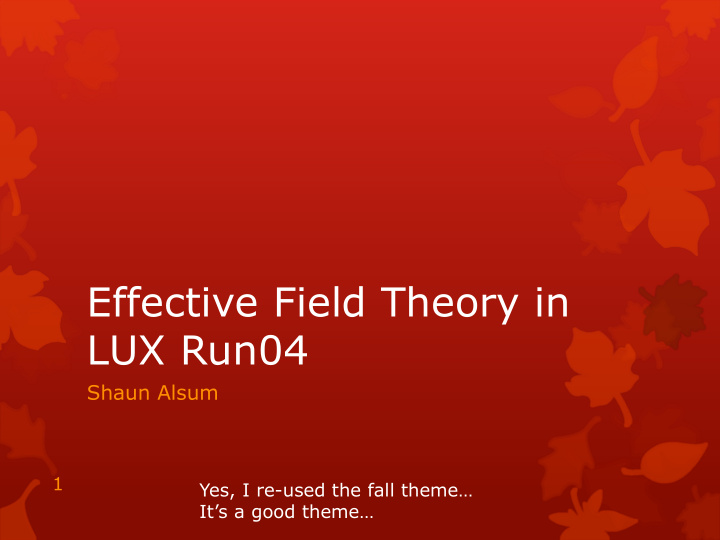



Effective Field Theory in LUX Run04 Shaun Alsum 1 Yes, I re- used the fall theme… It’s a good theme…
What Is EFT? Wick Haxton Wednesday http://teacher.pas.rochester.e du:8080/wiki/pub/Lux/AWGw orkshop171023_Agenda/DM_ LUX.pdf 2
For those without time machine access… Standard Spin Independent and Spin Dependent neglect other possible interactions In general, we want to account for any possible interaction that is allowed. There are 5 galilean and hermitian invariant quantities from which these operators can be built. I , i q (i q /m N ), v , S x , S N Identity Nucleon spin Relative velocity to q Transferred 3 WIMP spin momentum
Still livin ’ in the past These invariant quantities can be combined into 16 operators up to 2 nd order in momentum transfer and spin-exchange of 1 or less These are: 4
More recap… These operators can be expressed as combinations of 6 nuclear responses: These are very complicated… don’t ask me to explain exactly what each is These nuclear responses can be evaluated for a given 5 isotope.
What does it all matter? WIMP recoil spectrum is determined by: The lagrangian includes all possible interactions: The cross section is proportional to the matrix element squared The F ij is a form factor corresponding to operators O i and O j , which is a known combination of the known nuclear 6 responses referred to on the previous slide.
That’s a lot of factors! What are we to do? Interference can conspire to nullify almost any limits for a single parameter Only certain combinations of operators can interfere because they must satisfy symmetries (parity, etc) The proton and neutron couplings can interfere for any operator, however. O1 (SI) interference Ratio of 0.0218 at 50 keV (C n 1 =1, C p 1 =-1) 7
Still not fully sure… To get a proper limit, would want to re-write 𝑞 𝑞 𝑜 𝑞 + 𝑑 𝑗 𝑜 + 𝑑 𝑏 𝑑 𝑗 𝑞 𝑃 𝑗 𝑞 as 𝑃 𝑏 𝑞 for an 𝑜 𝑜 𝑑 𝑗 𝑃 𝑗 + 𝑑 𝑗 𝑜 𝑃 𝑏 𝑜 𝑃 𝑗 + 𝑜 𝑃 𝑗 𝑗 𝑗≠𝑏 𝑑 𝑏 𝑑 𝑏 𝑑 𝑏 arbitrary choice of 𝑑 𝑏 𝑜 for each interference class. Then minimize the above to get the worst-case value for each (𝑂) 𝑑 𝑗 𝑜 . Then use the PLR to determine a limit on 𝑑 𝑏 𝑜 which 𝑑 𝑏 would determine a worst-case limit on each other parameter. This is hard, so for now we just work on 1 parameter at a time while setting all others to 0 8
It’s all about the recoil spectrum Different combinations, then, have different recoil spectra as expected. Here are all of them for a 50 GeV WIMP coupling only to neutrons All Operators WIMP-neutron, m x = 50 GeV Relative Probability (arb units) 9 Recoil Energy (keV)
What makes a limit? Background PLR Model Signal Model 10
Changes to the Background? Energy Background Range PLR Model Extension Signal Model 11
Background Model Modification Initial analysis only extended to 50 keVnr. EFT signals can possibly extend much further than this for some heavier WIMP candidates. 83m Kr, which is not a huge problem for traditional energy ranges, may be an issue. 100 GeV 12 Recoil Energy (keV)
Changes to the Background? Energy Background Range PLR Model Extension Mathematica Signal package Parameters Signal Model (mass, spin, Specific halo, coupling) Energy Recoil Spectrum libNEST Binned Spectrum at S2 vs S1 many PDF Mathematica masses function
Changes to the Background? Energy Background Range PLR Model Extension Mathematica Signal package Parameters Signal Model (mass, spin, Specific halo, coupling) Energy Recoil Spectrum libNEST Binned Spectrum at S2 vs S1 many PDF Mathematica masses function
DMFormFactor - Mathematica Mathematica package written by Nikhil Anand, A. Liam Fitzpatrick, and W. C. Haxton. Returns the recoil energy (really momentum) spectrum in the form of a mathematica function given model inputs. Notable inputs: Halo type, earth velocity, local DM mean velocity, escape vel (set to typical values) WIMP spin Set to 1/2 WIMP mass Target isotope 15 Operator coefficients (for each op and proton vs neutron coupling)
Changes to the Background? Energy Background Range PLR Model Extension Mathematica Signal package Parameters Signal Model (mass, spin, Specific halo, coupling) Energy Recoil Spectrum libNEST Binned Spectrum at S2 vs S1 many PDF Mathematica masses function
Spectra generation Mathematica function calls DMFormFactor for different values of mass and different isotopes in an array. Resulting analytical spectra are integrated into bins used by the PLR analysis. Isotope Spectra are weighted by their abundance and then added together. The resulting array of varying masses and bins is stored in a text file whose name identifies the non-zero coupling constant used. 17
Changes to the Background? Energy Background Range PLR Model Extension Mathematica Signal package Parameters Signal Model (mass, spin, Specific halo, coupling) Energy Recoil Spectrum libNEST Binned Spectrum at S2 vs S1 many PDF Mathematica masses function
PDF creation libNEST is called for each mass in question. libNEST imports the recoil spectrum then simulates the S2 and S1 response given energies sampled from the imported spectrum. The result is stored as a root histogram to be used by the limit code. 19
How do we do? Operator 1 should closely match the SI result. We attempted to validate our process by comparing the limit on the WIMP-proton coupled operator 1 to our SI result. 20
Not great, but why? Low statistics (1000 per nSig, mass point)? Model mismatch? 12 14 17 21 33 55 400 100 21 1000 4000
Conclusion Getting there… Process is in place Background model must be validated and incorporated Difference between WIMP proton operator 1 limit and SI results must be understood After single-parameter limits, other intersting things could be done. Proton-neutron interference looked into? Joint PLR with experiments with other detector mediums? 22
Recommend
More recommend